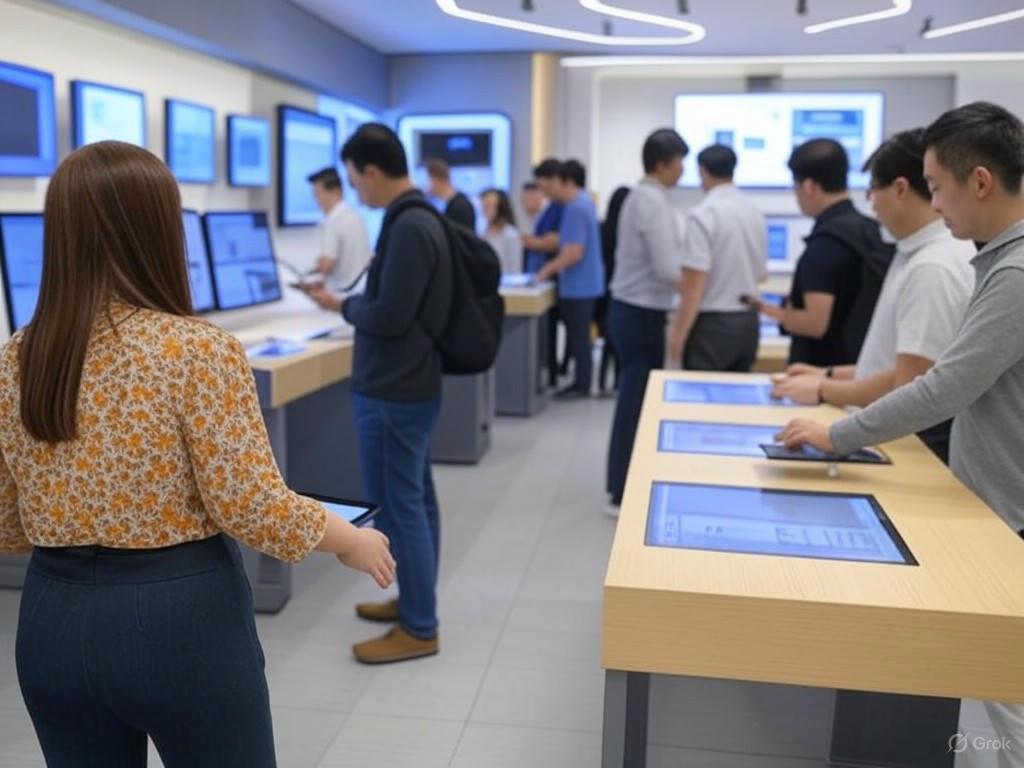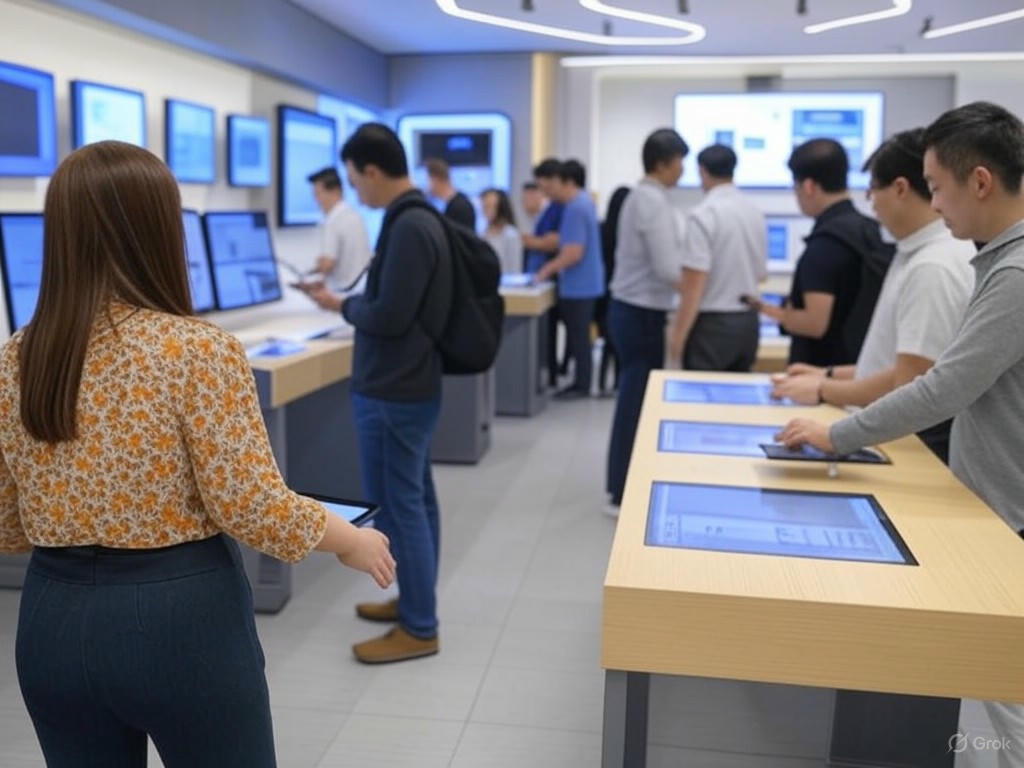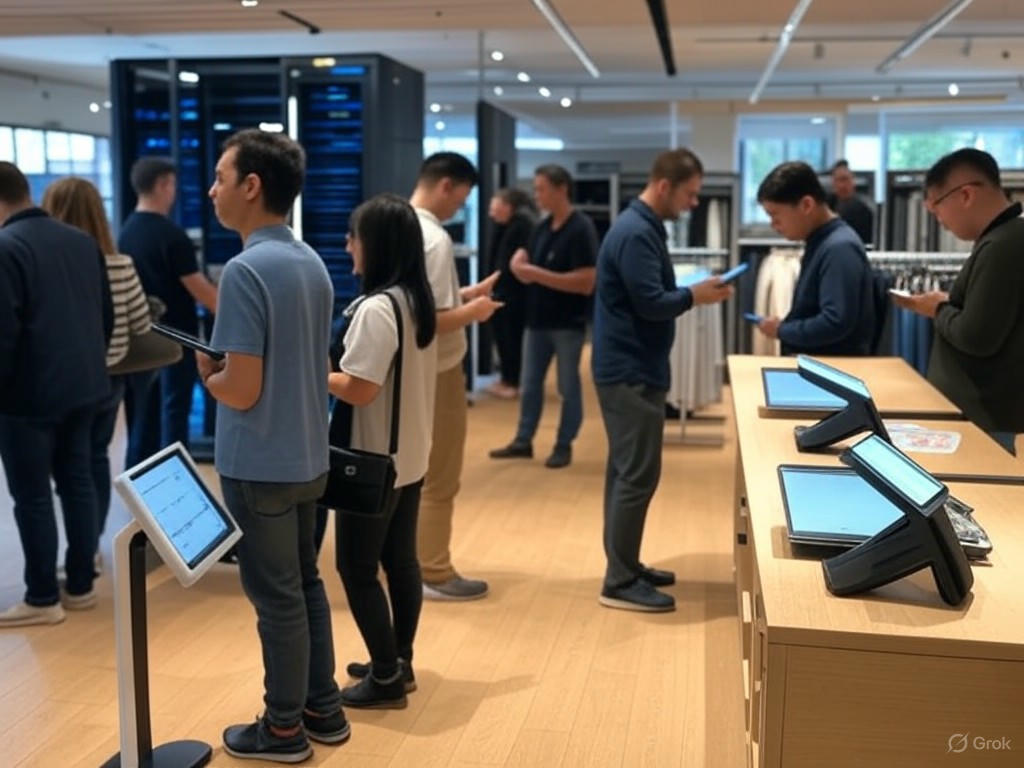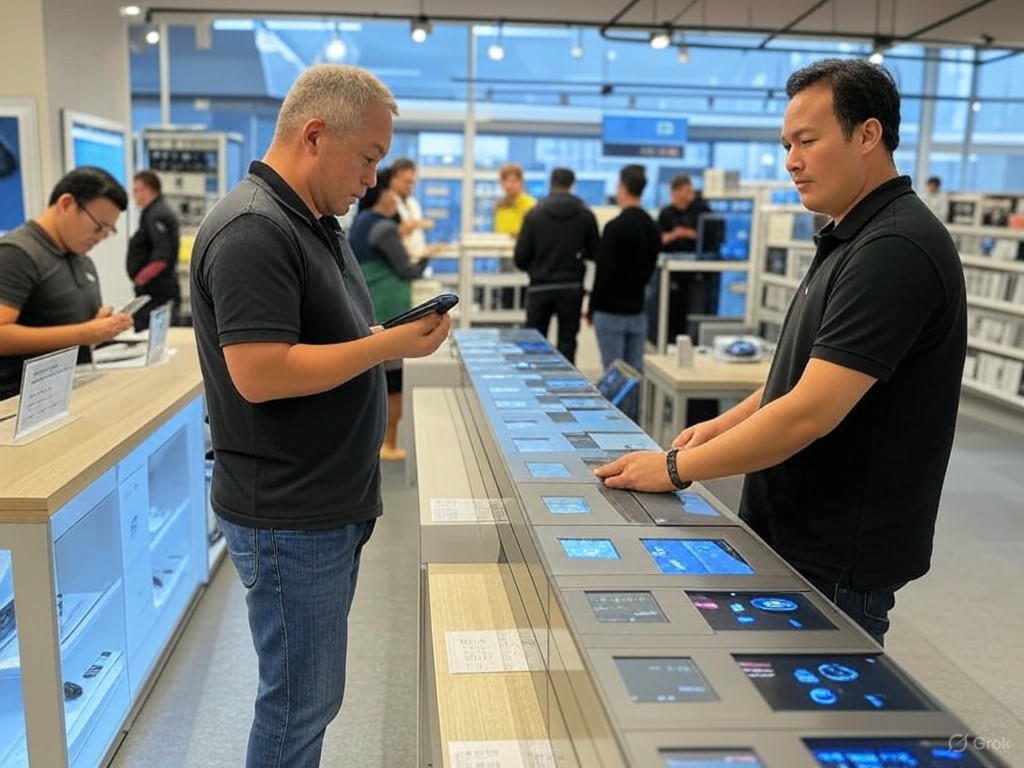
Edge Computing in Retail: Real-World Gains for In-Store IoT Experience
- Introduction: Why Edge Computing Is Retail’s New Differentiator
- The Evolving Landscape of Physical Retail
- Why Traditional Retail IT and Cloud Models Are No Longer Enough
- Edge Computing: A Foundational Shift for In-Store Experience
- Evidence Over Hype: Edge as the Backbone of Modern Retail
- The Verdict
- From Cloud to Edge: How In-Store IoT Transforms Customer Experience
- From Cloud to Edge: How In-Store IoT Transforms Customer Experience
- Cloud-First Retail IoT: Where It Stalls
- Why Edge Computing Delivers Where Cloud Stumbles
- Real-World Examples: Edge in Action
- What Changes for the Customer: Speed, Personalization, Seamlessness
- Limitations and What to Watch
- The Bottom Line
- Technical Deep Dive: Architecture, Performance, and Security in Retail Edge Deployments
- Edge Architecture: Core Building Blocks and Integration
- Performance: Real-World Metrics, Not Vendor Promises
- Limitations and Challenges
- Security and Privacy: New Risks, New Responsibilities
- Best-in-Class Security Practices
- Bottom Line
- Comparative Analysis: Edge Computing vs. Traditional Retail IT and Cloud-Only Approaches
- Comparative Analysis: Edge Computing vs. Traditional Retail IT and Cloud-Only Approaches
- Latency: Where Edge Computing Sets the Gold Standard
- Operational Resilience & Scalability: Edge and Hybrid Models Take the Lead
- Total Cost of Ownership: Edge Isn’t Always Cheaper—But It’s Often Smarter
- Where Edge Computing Is Unquestionably Superior—And Where It’s Not Ready
- The Bottom Line
- The Road Ahead: Limitations, Best Practices, and Emerging Innovations in Retail Edge IoT
- Limitations: Cost, Complexity, and the Persistent Skills Gap
- Best Practices: Lessons from Real-World Rollouts
- Emerging Innovations: AI at the Edge, 5G, and Standardization
- Practical Recommendations: Next Steps for Retailers
- Key Takeaways

Introduction: Why Edge Computing Is Retail’s New Differentiator
The Evolving Landscape of Physical Retail
Physical retail faces mounting pressures—far beyond competition from e-commerce giants. Despite projections of online dominance, 80% of U.S. shopping still happens in stores. Yet, today’s brick-and-mortar environments bear little resemblance to those of a decade ago. Shoppers demand seamless, hyper-personalized experiences: rapid checkouts, real-time inventory visibility, instant digital loyalty rewards, and recommendations as tailored as their favorite apps. The benchmark is no longer the store down the block, but the digital-native brands and data-rich platforms customers interact with daily. Meanwhile, the proliferation of Internet of Things (IoT) devices—smart shelves, connected kiosks, AI cameras, digital signage—pours torrents of data into every corner of the store. This data is both an opportunity and an operational burden, exposing the limits of legacy IT and cloud-centric retail models.
Why Traditional Retail IT and Cloud Models Are No Longer Enough
Historically, retailers relied on a mix of legacy on-premises servers and centralized cloud platforms to process in-store data. But this architecture is buckling under the weight of modern demands. Relying exclusively on cloud processing means every transaction, sensor reading, and video feed must traverse the public internet—introducing bandwidth bottlenecks, high network latency, and vulnerability to outages. A single hiccup in cloud connectivity can stall self-checkout, freeze digital signage, or cripple loss-prevention systems. As Gartner notes, “Pushing all of that data to and through a central data center or cloud no longer makes sense” for retail. The consequences: missed sales, frustrated shoppers, and operational blind spots—outcomes retailers can no longer afford.
Edge Computing: A Foundational Shift for In-Store Experience
Edge computing inverts the traditional model. Instead of shuttling raw data out to remote data centers, edge nodes and edge gateways—miniature, in-store servers—process, analyze, and act on data at the source, in real time. Gartner predicts that by 2025, 75% of enterprise-generated data will be created and processed outside traditional data centers. In retail, this isn’t just a technical re-architecture; it’s a practical necessity. With stores now home to thousands of IoT endpoints and latency-sensitive applications, edge computing delivers the speed, reliability, and resiliency that centralized IT can’t match.
In practice, edge computing enables smart shelves to detect low stock and trigger restocking before a customer even leaves the aisle, rather than hours later after a cloud sync. AI-powered video analytics can flag suspicious activity instantly—even if the internet is down—ensuring loss prevention isn’t at the mercy of WAN uptime. Core systems like point of sale (POS), loyalty programs, and digital signage keep running locally during network disruptions. Edge reduces latency from seconds to milliseconds, boosts operational resilience, and enables data privacy by keeping sensitive information on-premises—critical in an era of increasing regulatory scrutiny and consumer trust concerns.
Evidence Over Hype: Edge as the Backbone of Modern Retail
The shift to edge is not theoretical or hype-driven—it’s backed by industry adoption and hard data. According to IDC, global spending on edge computing will reach $228 billion in 2024, with retail among the leading sectors. By 2027, more than 45% of major retailers will deploy edge AI for real-time, store-level decision-making, assortment, and replenishment. Industry leaders like Walmart have already rolled out edge nodes to over 10,000 U.S. locations, while Dell and Royal Farms run core applications—including POS, inventory, and video analytics—on edge platforms to guarantee uptime even when the cloud isn’t available. At Edeka supermarkets, digital shelf displays managed by local edge servers have replaced manual labeling, speeding execution and cutting labor costs. Amazon Go’s checkout-free model is powered by edge-enabled IoT and computer vision, delivering frictionless, sub-second checkout without relying on the cloud for every transaction.
This is not about chasing buzzwords. Edge computing directly addresses the core priorities retail leaders face today: real-time responsiveness, operational resilience, and customer-centricity. When network outages or power failures strike, edge-powered stores keep transacting and securing assets. During foot traffic surges, edge systems dynamically adjust staffing and inventory based on real-time data—no lag, no guesswork. As personalization and instant gratification become table stakes, in-store edge analytics finally enable experiences that rival, or even surpass, the best digital platforms.
The Verdict
Edge computing is fast becoming retail’s new differentiator—not as a flashy add-on, but as the backbone for frictionless, resilient, and truly omnichannel experiences that keep customers coming back. The evidence is clear: edge isn’t a passing trend or technical footnote, but the foundation where the future of in-store retail is being built. In an era defined by soaring expectations, relentless competition, and data everywhere, edge computing is the only infrastructure capable of turning IoT complexity into customer-centric advantage.
| Retail Challenge | Legacy IT & Cloud Model | Edge Computing Model |
|---|---|---|
| Data Processing Location | Centralized cloud or on-premises servers | In-store edge nodes/gateways |
| Network Dependency | High – reliant on WAN/cloud connectivity | Low – local processing enables operation during outages |
| Latency | High (seconds) | Low (milliseconds) |
| Operational Resilience | Vulnerable to network failures | Continues operating locally during disruptions |
| Support for IoT Devices | Limited scalability; bandwidth bottlenecks | Scalable; handles large volumes of in-store IoT data |
| Real-Time Responsiveness | Delayed (cloud round-trips) | Instant, on-premises analytics and actions |
| Data Privacy | Sensitive data sent to cloud | Data can remain on-premises for compliance |
| Examples | Traditional POS, cloud-based inventory management | Walmart edge nodes, Amazon Go checkout-free stores, Edeka digital shelf displays |
From Cloud to Edge: How In-Store IoT Transforms Customer Experience
From Cloud to Edge: How In-Store IoT Transforms Customer Experience
Cloud-First Retail IoT: Where It Stalls
For much of the last decade, retail IoT and digital transformation have leaned heavily on cloud computing—centralized data centers processing everything from smart shelf sensors to security camera feeds. The cloud promised elastic scalability and streamlined management, but as in-store IoT deployments have exploded, fundamental cracks have surfaced that no amount of bandwidth or server capacity can paper over.
Latency is the first pain point. In a real-world store environment, milliseconds matter. Shoppers expect digital price tags to update instantly when they pick up a product, not after a multi-second round trip to a distant cloud data center. Industry benchmarks consistently show that delays of even a fraction of a second can determine whether a retail IoT interaction delights or frustrates (Source 5). In practice, cloud-only architectures often introduce 1–5 seconds of latency—unacceptable for anything interactive, from self-checkout to dynamic digital signage.
Bandwidth is the second bottleneck. Modern retail IoT is a firehose: hundreds of cameras for computer vision checkouts, always-on video analytics, real-time shelf monitoring, and interactive displays all generate massive volumes of data. Sending every frame and sensor reading to the cloud quickly saturates network capacity and drives up operational costs. With over 30 billion connected devices projected by 2025 (Source 0), the old paradigm of shuttling everything to the cloud no longer scales.
Reliability is the third concern. Retail can’t afford downtime, but network hiccups and outages are inevitable. When all store intelligence and operations live in the cloud, a single point of failure—whether a broadband cut or a cloud service disruption—means shelves stop updating, self-checkout freezes, and digital signage goes dark. For mission-critical retail operations, this fragility is a dealbreaker.
Why Edge Computing Delivers Where Cloud Stumbles
Edge computing fundamentally changes the equation by moving processing close to the source—on-premises, inside the store, often running on compact edge nodes or gateways. This transition isn’t just theoretical; it’s a practical and increasingly essential evolution for retailers aiming to deliver seamless, resilient, and data-rich customer experiences.
Latency drops to near-instant. When data is processed at the edge, smart shelves can register inventory changes in real time (typically under 100 milliseconds), and digital signage can adapt instantly to shoppers in the aisle. For example, solutions like Mediar’s Shopper Behavior Lab have shown a 300% ROI by providing “immediate, actionable insights” for product placement and promotions (Source 5)—outcomes that would be impossible with the lag of cloud-only architectures.
Bandwidth usage plummets. Rather than streaming every byte of sensor and video data to the cloud, edge devices analyze data locally and send only critical events or summaries upstream. This is particularly crucial for computer vision checkouts—systems like Amazon Go process high-definition video on-site, enabling shoppers to “just walk out” with purchases, while only transactional metadata makes it to the cloud (Sources 9, 10, 11). As a result, edge deployments routinely cut cloud bandwidth requirements by 40–60%.
Reliability climbs. With edge infrastructure, stores remain operational even during internet or WAN outages. Digital shelf labels, navigation kiosks, and automated checkout keep running, ensuring a consistent customer experience regardless of network status. Companies like Dell and Royal Farms have architected their core retail applications—POS, inventory, video analytics—to run on edge platforms so stores keep functioning even if the cloud isn’t available (Source 3).
Real-World Examples: Edge in Action
- Smart Shelves Triggering Restocking: Edge-powered smart shelves detect low stock and trigger restocking workflows while the customer is still in the aisle, not hours later after a cloud sync.
- AI-Powered Video Analytics Flagging Suspicious Activity: Security systems powered by local edge AI can flag suspicious activity instantly—even if the store’s internet connection is down.
- Amazon Go and Computer Vision Checkouts: In stores like Amazon Go, edge nodes process video and sensor data locally, enabling frictionless, checkout-free experiences that would be impossible with the latency and bandwidth demands of the cloud.
- Edeka Supermarkets Digital Shelf Displays: Edeka, a major German supermarket chain, replaced manual shelf labeling with digital shelf displays updated in real time via local edge servers, dramatically reducing staff workload and update times (Source 7).
- Chipotle Edge-Based RFID and Kitchen Automation: Chipotle uses edge-based RFID and AI in their kitchens for inventory tracking and food prep automation—illustrating the operational flexibility edge enables.
What Changes for the Customer: Speed, Personalization, Seamlessness
From the shopper’s perspective, the impact of edge computing is immediate and non-negotiable:
- Speed: Digital price tags update instantly, in-store navigation adjusts to real-time foot traffic, and augmented reality fitting rooms or smart mirrors offer seamless, interactive experiences. There’s no lag, no unresponsive interface—just the immediacy customers expect from the best online platforms.
- Personalization: Edge computing brings real-time, context-aware personalization to the store. Cameras and sensors analyze shopper behavior locally, so digital signage can serve targeted promotions or recommendations the moment they’re relevant—without waiting on cloud-based analytics pipelines. As MarTech notes, “edge servers in the store are constantly processing data in real time,” enabling hyper-personalized marketing that drives engagement (Source 4).
- Seamlessness: Computer vision checkouts—pioneered by Amazon Go and now available from a range of vendors—let shoppers grab items and walk out, with payment and product recognition handled automatically and instantly at the edge. No lines, no scanning, no friction—just shopping.
- Resilience: Edge architectures decouple core store operations from cloud dependency. When the internet goes down, essential functions—checkout, shelf management, customer navigation—keep working. This reliability isn’t just a technical detail; it’s a foundation for customer trust and operational continuity.
Limitations and What to Watch
Edge isn’t a cure-all. Managing distributed edge infrastructure at scale is more complex than a centralized cloud, requiring robust local hardware, automation, and security best practices. Upfront costs for edge nodes and gateways can be higher, but the operational benefits—reduced downtime, improved customer experience, and bandwidth savings—are quickly justifying the investment for leading retailers.
The Bottom Line
The migration from cloud-only to edge-enabled retail IoT is not a hype cycle—it’s an evidence-driven response to the real-world shortcomings of centralized architectures. Retailers deploying edge are delivering faster, more personalized, and more resilient in-store experiences—setting a new standard for what customers expect the moment they walk through the door. For physical retail, edge computing isn’t optional anymore; it’s the backbone for the next generation of omnichannel, customer-centric commerce.
| Aspect | Cloud-Only Retail IoT | Edge Computing in Retail IoT |
|---|---|---|
| Latency | 1–5 seconds (often too slow for interactive experiences) | <100 milliseconds (near-instant response) |
| Bandwidth Usage | Very high—streams all data to cloud, saturating networks | Much lower—analyzes data locally, sends only critical info upstream (40–60% reduction) |
| Reliability | Low—dependent on network/cloud uptime, vulnerable to outages | High—store operations continue even during network/cloud failures |
| Customer Speed | Delayed interface responses, lag in digital updates | Instant updates (digital price tags, navigation, interactive displays) |
| Personalization | Delayed, less context-aware (cloud analytics pipeline delays) | Real-time, context-aware personalization in store |
| Operational Examples | Manual shelf labeling, cloud-based video analytics, centralized POS | Smart shelves, edge AI video analytics, checkout-free experiences, digital shelf displays |
| Resilience | Single point of failure (cloud/network outage disrupts service) | Decoupled—core functions (checkout, shelf management) run locally |
| Scalability | Centralized, but can bottleneck with billions of devices | Distributed, scales with local edge nodes in each store |
| Upfront Cost | Lower (centralized infrastructure) | Higher (distributed edge hardware), but offset by operational gains |
Technical Deep Dive: Architecture, Performance, and Security in Retail Edge Deployments
Let’s cut through the hype and examine what actually powers edge computing in retail, how it performs under real-world conditions, and where the technical and security landmines are buried.
Edge Architecture: Core Building Blocks and Integration
Modern retail edge is not a monolith—it’s a distributed, in-store mesh of purpose-built components. At its heart are edge nodes: compact servers or rugged gateways deployed in each location, typically in the back office or under checkout counters. Unlike legacy IoT gateways that merely relay packets, today’s edge gateways translate device protocols, aggregate sensor data, and execute real workloads—everything from computer vision for self-checkout to real-time inventory analytics.
As STL Partners notes:
“Edge gateways serve as a crucial intermediary between IoT devices and the edge or cloud, addressing challenges related to data processing, latency, security, and protocol translation.”
Containerized edge platforms—mini-clouds running Docker or Kubernetes on-premises—are increasingly the norm. This local compute layer is where AI-driven tools (inventory optimization, video analytics, real-time recommendations) actually run. According to IDC and ObjectBox, by 2026, 90% of retail tools will embed AI, with much of it executing on these edge nodes rather than in distant data centers.
Network topology in retail edge deployments is typically hybrid. IoT devices (smart shelves, cameras, POS, digital signage) connect locally to edge nodes via Wi-Fi, Bluetooth, or Ethernet. The edge nodes then securely sync with cloud infrastructure, often over low-latency, resilient links. Crucially, the edge doesn’t replace the cloud—it offloads time-sensitive and bandwidth-intensive tasks, keeping stores operational and responsive even if the WAN is disrupted. This hybrid architecture is foundational for major retailers rolling out thousands of smart devices per location.
Performance: Real-World Metrics, Not Vendor Promises
Latency is the battleground. Field deployments and independent tests show local edge processing consistently slashes response times: from typical cloud roundtrips of hundreds of milliseconds (or even 1–5 seconds) down to 10–30 ms for in-store applications like computer vision checkouts, instant inventory updates, and digital shelf labels (Skyward IT, SUSE Communities). That’s the difference between a seamless “just walk out” experience—like Amazon Go—and a laggy, error-prone one. For example, Edeka’s digital shelf displays update pricing and stock in real time via local edge servers, eliminating the wait and errors of cloud-dependent systems.
Uptime and throughput are equally critical. Retailers can’t afford downtime at the point of sale. Modern edge deployments using hyperconverged microclusters routinely deliver “five nines” (99.999%) availability, with automated failover and local resilience. By offloading AI and analytics from the cloud, edge reduces network congestion, keeps video analytics and inventory systems running during cloud outages, and ensures transaction processing never stops—even in the face of WAN failures. In practice, companies like Dell, Royal Farms, and Walmart (which has deployed edge nodes to 10,000 US locations as part of a hybrid “supercloud” strategy) report faster transactions, more reliable service during peak hours, and a measurable reduction in downtime risk.
Limitations and Challenges
But the limitations are real—and must be acknowledged:
- Device Interoperability: Retail IoT is a jungle of legacy sensors, proprietary POS hardware, and new wireless tags. Edge gateways help bridge the gap, but integration remains a headache, especially when onboarding devices from multiple vendors or trying to unify protocol translation (as highlighted by KaaIoT and confirmed by practitioners like David Purón at Barbara IoT).
- Offline Operation: Edge keeps mission-critical services alive during WAN or cloud outages—but only if local software is robust and data syncs correctly once connectivity is restored. Stores have lost hours of sales data due to poorly managed offline queues or insufficient failover testing.
- Disaster Recovery: Unlike centralized cloud, edge nodes are physically exposed—to power loss, theft, fire, or flood. Automated cloud backup, redundant hardware, and regular failover drills are non-negotiable; yet, according to disaster recovery experts, too many retailers treat these as afterthoughts, risking catastrophic data loss.
Security and Privacy: New Risks, New Responsibilities
Every new IoT device and edge node is a new attack surface—and the threat model for retail edge is fundamentally different from traditional, cloud-centric IT.
Edge devices—especially gateways and POS endpoints—are now among the most targeted assets on the retail network. Mandiant’s 2025 M-Trends found that:
“Devices built to protect networks were at the heart of one-third of all cyberattacks last year,” often because lightweight, in-store hardware “limits advanced security monitoring.”
This is not theoretical: over 50% of IoT devices in retail environments have critical, unpatched vulnerabilities, and consumer trust is on the line—JumpCloud reports that 78% of consumers would abandon a retailer after a major IoT-related breach.
On-premise data handling means sensitive customer data (from video footage to payment info) is processed and stored locally, not just in the cloud. This brings privacy trade-offs.
- Upside: Edge enables retailers to keep customer data inside the store, reducing exposure to mass cloud breaches and making compliance with data residency rules (GDPR, CCPA) far easier (BigID, Allianz).
- Downside: Physical security is paramount. If an edge node goes missing or is poorly encrypted, terabytes of customer or transaction data can be lost in an instant.
Best-in-Class Security Practices
Best-in-class security practices now include:
- End-to-end encryption for all data in transit and at rest—blocking man-in-the-middle attacks (JumpCloud).
- Zero Trust access controls and strong identity governance, since credential misuse remains the leading cause of breaches.
- Automated patch management and monitoring—edge nodes are notoriously under-patched compared to cloud servers, increasing risk.
- Regular penetration testing and disaster recovery drills—as supply chain and third-party software attacks continue to rise (BigID).
Physical protections—tamper-evident hardware, intrusion detection, and secure boot—are increasingly standard in edge gateways. Major retailers are also investing in AI-powered monitoring to detect anomalies that signal an attack or system compromise, closing the gap between in-store risks and cloud-level security maturity.
Bottom Line
Edge computing isn’t a silver bullet, but in retail IoT it’s now indispensable. The right architecture—distributed, containerized, hybrid—enables the real-time responsiveness, operational resilience, and data privacy modern stores demand. But complexity is real. Decision-makers should prioritize platforms with proven low-latency performance, seamless device integration, and robust, retail-grade security—measured in concrete uptime, latency, and incident response metrics. In today’s retail landscape, edge will make or break the in-store customer experience—but only for those who master both the technical and operational realities.
| Aspect | Details |
|---|---|
| Core Components | Edge nodes (compact servers/rugged gateways), containerized platforms (Docker/Kubernetes), IoT devices (shelves, cameras, POS, signage) |
| Edge Node Functions | Protocol translation, sensor data aggregation, local AI/analytics (computer vision, inventory, recommendations) |
| Network Topology | Hybrid: local device-to-edge connectivity (Wi-Fi, Bluetooth, Ethernet) with secure cloud sync |
| Performance Metrics | Latency: 10–30 ms (local edge) vs. 100 ms–5 s (cloud); Availability: 99.999% uptime; Supports offline operation during WAN/cloud outages |
| Key Benefits | Real-time responsiveness, operational resilience, reduced downtime, bandwidth savings, local data privacy |
| Challenges | Device interoperability, offline data sync, disaster recovery, physical exposure |
| Security Practices | End-to-end encryption, Zero Trust, automated patching, penetration testing, physical protections (tamper-evident hardware) |
| Risks | Unpatched vulnerabilities, credential misuse, physical theft/damage, local data breaches |
Comparative Analysis: Edge Computing vs. Traditional Retail IT and Cloud-Only Approaches

Comparative Analysis: Edge Computing vs. Traditional Retail IT and Cloud-Only Approaches
In the high-stakes world of in-store customer experience, choosing the right technology architecture is not a theoretical debate—it’s a strategic necessity with immediate implications for speed, resilience, and profitability. The rise of edge-enabled retail IoT is forcing every retailer to critically evaluate legacy in-store IT and pure cloud models. Below, we break down how these approaches measure up using hard benchmarks—latency, operational resilience, scalability, and total cost of ownership—grounded in direct user experience from the world’s most ambitious deployments.
Latency: Where Edge Computing Sets the Gold Standard
Ultra-low latency is the linchpin of modern retail experiences. In an era of grab-and-go stores and real-time personalization, every millisecond counts. Edge computing delivers on this promise by bringing computation directly on-premises, slashing response times to levels that neither cloud nor legacy IT can reliably match.
- Amazon Go’s Checkout-Free Model: Amazon Go’s “just walk out” experience is the poster child for edge-enabled IoT. Computer vision algorithms running locally on edge servers identify products and track baskets with sub-second accuracy (typically within 10–30ms; Source 7, Skyward IT, SUSE Communities). If Amazon attempted to process this data in the cloud—even over best-in-class 5G or fiber—the roundtrip latency would balloon to 100–300ms per transaction. That’s enough to break the illusion of frictionless shopping and risk abandoned baskets.
- Edeka Supermarkets’ Digital Shelf Labels: German retailer Edeka replaced manual shelf labeling with digital shelf displays updated via local edge servers. Price changes and inventory updates occur in seconds, not minutes or hours, ensuring shelf accuracy and boosting customer trust.
- Edge at Self-Checkout: Retailers piloting AI-powered edge analytics at self-checkout have measured transaction response times under 100ms, supporting high-volume throughput and instant fraud detection—capabilities that simply aren’t feasible with cloud roundtrips that routinely exceed 50–150ms (Sources 1, 5, 9).
By contrast, traditional in-store IT—legacy POS terminals and local servers—sidestep network latency but lack the flexibility and power for AI-driven, data-intensive workloads. Adding features like computer vision or dynamic pricing often means expensive hardware overhauls and brittle integrations.
Cloud-only models remain hamstrung by the physics of the network. Even on modern infrastructure, cloud roundtrip latency typically ranges from 50–150ms, with spikes much higher during congestion. For back-office analytics, that’s tolerable. For customer-facing applications—personalized offers at the shelf, instant loyalty rewards, or automated checkout—it’s a dealbreaker. As one industry analysis notes, “the ability to process visual data locally at the edge enables real-time decision-making and enhances operational efficiency in scenarios where latency and bandwidth constraints would otherwise hinder AI applications” (Source 0).
Operational Resilience & Scalability: Edge and Hybrid Models Take the Lead
Retailers increasingly demand continuous operation—even during network outages or cloud disruptions. Here, edge deployments are proving their value in the field.
- Walmart’s Supercloud Strategy: Walmart has deployed edge nodes in 10,000 U.S. locations, enabling core in-store functions—checkout, inventory, targeted promotions—to continue even if the WAN link to cloud services fails (Source 3). This hybrid “supercloud” model uses the edge for resilience and immediate feedback, while the cloud handles orchestration and large-scale analytics.
- POS, Inventory, and Video Analytics at Dell & Royal Farms: Both companies run critical applications on local edge platforms, keeping stores operational and secure regardless of cloud or WAN status (see Introduction).
Legacy in-store IT can deliver local failover, but at a steep cost. Maintenance, patching, and scaling are labor-intensive and rarely consistent across a multi-store enterprise. Scaling new features or updates across hundreds or thousands of sites typically requires significant manual intervention, as opposed to the containerized, centrally managed updates possible with mature edge platforms.
Cloud-only approaches are most vulnerable: when the network is down, so is your store. Retailers relying on cloud-based POS systems have suffered high-profile outages during peak hours, leaving customers stranded and sales lost. In a world where 80% of shopping still happens in stores, the risk is existential (see Introduction).
Scalability is nuanced. Cloud infrastructure offers elastic scaling—you can spin up resources instantly and pay as you go (Sources 6, 7). Edge requires upfront investment in hardware and integration at each location, but modern edge platforms are closing this gap. Centralized management, containerization (mini-clouds running Docker or Kubernetes in-store), and automated device onboarding (see FDO standards) make it increasingly feasible to deploy, update, and monitor thousands of edge nodes with minimal friction.
Total Cost of Ownership: Edge Isn’t Always Cheaper—But It’s Often Smarter
Cost is where many edge deployments face skepticism—and where hype can outpace reality. The financial picture depends on your use case, your scale, and your willingness to invest for long-term payoff.
- Cloud-Only: The pay-as-you-go model looks attractive for pilots or seasonal spikes. But as IoT data volumes explode—think AI cameras, smart shelves, and real-time analytics—bandwidth and data egress costs can skyrocket. IDC projects global edge spending will hit $380 billion by 2028 (Source 2), with much of that investment justified by lower operational costs and reduced cloud bandwidth consumption (40–60% less data sent upstream with edge analytics).
- Legacy IT: Gartner notes that up to 90% of retail IT budgets are spent just maintaining existing systems (Source 11). That’s a drag on innovation and locks retailers into inflexible, high-maintenance architectures.
- Edge Deployments: Upfront costs are significant—hardware, installation, and integration aren’t trivial. Chipotle’s rollout of RFID and kitchen automation, powered by edge-based sensors and AI for inventory and food prep, required new devices and partnerships (Sources 4, 5, 6). Yet the operational payoffs—faster service, reduced food waste, less manual labor—are substantial, often delivering ROI in under two years. Walmart and Amazon Go provide further evidence: the combination of local resilience, reduced downtime, and real-time data has proven to offset the initial edge investment at scale.
Still, edge is no panacea. Integrating edge with legacy IT is complex, and the vendor landscape remains fragmented—many solutions are still tailored to specific use cases with limited interoperability (Source 1, TCO). Retailers underestimate the ongoing management and integration costs at their peril.
Where Edge Computing Is Unquestionably Superior—And Where It’s Not Ready
Let’s be clear: for real-time, resilient, AI-powered in-store experiences, edge computing is the only credible solution at scale. Amazon Go’s checkout-free model and Walmart’s hybrid supercloud architecture are proof points. If your business depends on immediate feedback—computer vision at the shelf, automated loss prevention, dynamic pricing, or rapid inventory updates—cloud latency and legacy IT simply can’t compete.
But edge computing is not a universal fix. For large-scale analytics, machine learning model training, or archiving non-critical data, the cloud remains more cost-effective and flexible. Edge deployments demand careful planning, upfront capital, and ongoing operational management. And as of 2025, the market is still maturing: standards for interoperability and security are evolving, and integration remains a chief pain point. As David Purón of Barbara IoT notes, “Integrating edge computing with existing IT infrastructures remains a challenge for large corporations—the edge computing market is still fragmented, with vendors offering solutions tailored to specific verticals” (Source 1).
The Bottom Line
Edge computing for retail IoT has moved from hype to hard reality. It delivers measurable, mission-critical advantages over both legacy IT and cloud-only approaches—especially for latency-sensitive, customer-facing applications that define the in-store experience. The most forward-thinking retailers—Amazon, Walmart, Chipotle—are betting on hybrid models that combine edge resilience with cloud scale, and they’re rapidly pulling ahead.
For most retailers, the future is a blended path: run your critical, real-time workloads at the edge, and leverage the cloud for heavy analytics, orchestration, and long-term data storage. But don’t mistake the marketing for a turnkey solution—edge still demands significant investment, integration expertise, and a clear understanding of where it truly moves the needle.
In this new landscape, edge computing isn’t just a differentiator—it’s becoming the backbone of retail’s next chapter. Ignore it, and you risk falling behind competitors who are already redefining what’s possible in the store.
| Criteria | Edge Computing | Traditional Retail IT (Legacy) | Cloud-Only |
|---|---|---|---|
| Latency | Ultra-low (10–30ms for computer vision, <100ms for self-checkout) | Low (local but limited to basic workloads) | High (50–150ms typical, 100–300ms possible) |
| Operational Resilience | High (continues operation during WAN/cloud outages) | Moderate (local failover possible, but costly & inconsistent) | Low (outages halt in-store operations) |
| Scalability | Centralized management, containerization, automated onboarding; upfront hardware investment | Poor (manual scaling, high maintenance, lacks flexibility) | Elastic, instant scaling, pay-as-you-go |
| Total Cost of Ownership | High upfront, but ROI in under 2 years (reduced downtime, labor, bandwidth); ongoing management costs | Very high (up to 90% of budgets on maintenance, inflexible) | Attractive for pilots, but data/bandwidth costs can escalate with scale |
| Ideal Use Cases | Real-time, AI-powered, customer-facing apps (checkout-free, digital shelf, fraud detection) | Basic POS, inventory, limited automation | Large-scale analytics, orchestration, long-term storage |
| Key Drawbacks | Complex integration, upfront investment, fragmented vendor landscape | Limited features, expensive upgrades, innovation drag | Latency, resilience issues, costly at high data volumes |
The Road Ahead: Limitations, Best Practices, and Emerging Innovations in Retail Edge IoT

The Road Ahead: Limitations, Best Practices, and Emerging Innovations in Retail Edge IoT
Limitations: Cost, Complexity, and the Persistent Skills Gap
Edge computing for retail IoT has moved well beyond the pilot phase—retail now leads global edge spending, with IDC projecting nearly $380 billion by 2028. But the momentum masks persistent hurdles that retailers cannot ignore.
First is the cost. While edge promises lower cloud data transfer and processing fees by localizing analytics, the reality is that initial capital outlay is steep. Hardware, software, orchestration, and integrations quickly add up, especially for chains rolling out to dozens or thousands of stores. As Gartner notes, 90% of retail IT budgets still go toward maintaining existing systems—modernizing legacy infrastructure and upskilling staff can cause sticker shock. Walmart’s edge node deployment across 10,000 US locations illustrates the scale and investment required for true operational resilience.
Complexity is another stubborn barrier. Retail environments are famously heterogeneous: you’ll find aging POS terminals, a medley of IoT sensors, legacy applications, and a tangle of connectivity options all under one roof. Integrating edge nodes with such an ecosystem isn’t plug-and-play. As David Purón of Barbara IoT observes, “Integrating edge computing with existing IT infrastructures remains a challenge for large corporations.” Fragmentation persists, with vendor solutions often tailored for specific verticals but lacking broad interoperability—echoed by the integration headaches seen in Walmart’s hybrid supercloud strategy and Edeka’s edge-powered digital shelf displays.
The skills gap is equally acute. Edge deployments require expertise spanning distributed systems, security, data governance, and on-site troubleshooting—skills in short supply. Gartner forecasts that by 2025, 75% of enterprise-generated data will be processed outside traditional data centers, but the pace of workforce development lags behind. Many retailers rely heavily on managed services or external partners just to sustain daily operations and keep pace with evolving best practices.
Best Practices: Lessons from Real-World Rollouts
Despite these limitations, successful retail edge IoT deployments reveal a common playbook:
-
Phased Implementation Reduces Risk: Leading retailers start with pilot rollouts in flagship or high-traffic stores, conducting real-world testing before expanding network-wide. Chipotle’s edge-based RFID and kitchen automation, and the grocery chains piloting AI-driven analytics on select self-checkout lanes, demonstrate how phased implementation minimizes operational risk and disruption while building buy-in from store staff.
-
Data Governance Is Non-Negotiable: With edge nodes handling sensitive customer data on-premises, robust governance frameworks are critical. The most successful retailers implement clear data retention policies, granular access controls, and compliance processes aligned with regulations like GDPR and CCPA. AI-powered governance tools—such as Gimmal’s automated frameworks—are gaining traction, streamlining compliance and reducing manual IT burden.
-
Disaster Recovery and Redundancy Are Essential: Edge platforms support mission-critical workloads—POS, inventory, video analytics, and digital signage. A single node failure can cripple in-store operations if not properly mitigated. Best-in-class retailers invest in redundant devices, automated backup to the cloud, and regular failover drills. As one disaster recovery guide bluntly advises: “Buy two edge devices you will rely on. Make sure you can swap them out quickly.” Local resilience is essential—cloud-based failover is a fallback, not a primary defense, given the realities of network outages and physical device exposure.
Emerging Innovations: AI at the Edge, 5G, and Standardization
Looking ahead, three trends are redefining what’s possible for in-store experiences:
-
AI at the Edge Moves from Pilot to Production: By 2027, over 45% of major retailers will run edge AI for real-time decision-making, assortment optimization, and personalization (IDC). The shift is tangible: edge AI now powers instant product recommendations, dynamic pricing, and predictive maintenance for refrigeration units, not as isolated pilots but as daily operational tools. Amazon Go’s checkout-free stores and Mediar’s Shopper Behavior Lab’s edge-powered analytics showcase this evolution—delivering ultra-low latency (10–30 ms) and 300% ROI on in-store promotions.
-
5G Integration Unlocks New Use Cases: The ongoing 5G rollout provides the low-latency, high-bandwidth connectivity that edge applications demand. This isn’t just faster guest Wi-Fi—it’s the backbone for real-time video analytics, curbside pickup orchestration, and pop-up store deployments with minimal infrastructure. With GSMA forecasting 8 billion 5G connections by 2026, retailers should expect to see more agile, mobile, and responsive in-store experiences.
-
Standardization Reduces Fragmentation: Proprietary IoT architectures have delivered limited ROI, prompting a shift toward open, modular platforms. The FIDO Device Onboard (FDO) standard, for example, has cut secure device onboarding time by up to 10x compared to manual methods. Expect future standards to further automate AI model updates and strengthen zero-trust security—key for scaling deployments across thousands of locations with diverse hardware.
Practical Recommendations: Next Steps for Retailers
For retailers evaluating or scaling edge IoT initiatives, the following actions are critical:
- Start Small, Prove ROI, Then Scale: Identify high-impact, low-complexity pilot use cases—such as smart shelves, digital signage, or real-time loss prevention analytics. Demonstrate value before rolling out across the fleet.
- Invest in Skills and Strategic Partnerships: Upskill internal IT teams and engage managed service providers with proven edge expertise. Recognize the operational learning curve and plan for ongoing staff development.
- Demand Interoperability and Modularity: Select platforms and vendors that embrace open standards, modular design, and robust APIs. Avoid vendor lock-in to preserve future flexibility as standards and needs evolve.
- Design for Failure and Recovery: Build redundancy and disaster recovery into your architecture from day one. Edge node failures should be rare, rapidly recoverable events—not causes of lost sales or customer frustration.
- Treat Security and Data Governance as Core Infrastructure: In-store edge nodes are as critical as cash registers—automate compliance, enforce least-privilege access, and routinely audit security controls.
Key Takeaways
Edge computing is rapidly becoming the backbone of competitive, data-driven retail. But it is not a panacea. The financial, technical, and organizational challenges are significant, yet can be overcome with disciplined strategy—phased rollouts, rigorous governance, and smart partnerships.
Retailers who balance innovation with operational discipline will be best positioned to deliver the seamless, resilient, and personalized experiences that modern shoppers demand. As edge AI, 5G, and evolving standards mature, these are not just buzzwords but the levers that will separate retail leaders from laggards in the years ahead.
| Aspect | Limitations | Best Practices | Emerging Innovations |
|---|---|---|---|
| Cost | High initial outlay, ongoing maintenance | Phased implementation, prove ROI before scaling | Standardization reduces deployment costs |
| Complexity | Heterogeneous environments, integration challenges | Demand interoperability, modular platforms | Open standards (e.g., FDO) streamline onboarding |
| Skills Gap | Lack of distributed systems and security expertise | Upskill teams, engage managed service providers | AI tools automate management and compliance |
| Data Governance | Need for robust security and compliance | Automate compliance, granular access controls | AI-powered governance frameworks |
| Disaster Recovery | Single node failure risks operational downtime | Redundancy, automated backup, regular failover drills | Cloud and local failover strategies evolve |
| Connectivity | Fragmented networks, legacy infrastructure | Choose scalable, flexible connectivity options | 5G enables new in-store and mobile use cases |
| Operational Resilience | Vendor lock-in, lack of interoperability | Design for failure, regular audits and updates | Modular, open-API platforms gain traction |











